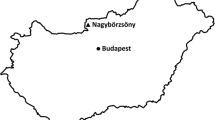Abstract
Cronstedtite from Lostwithiel, Cornwall, England, in which two polytypic groups (A and C) are present within the same crystal, has been investigated using various techniques to reveal the distribution of the two groups and the relationship between polytypic structure and chemical composition. X-ray precession photographs from cleaved fragments of pyramidal crystals revealed the variable proportions of the two groups from the top to the base. Near the top, the crystal consists entirely of group C, with 1T as the dominant polytype. Near the base, both groups A and C are present. Back-scattered electron images from cross-sections parallel to the pyramidal axis showed mosaic contrast near the base, suggesting that two compositionally-different domains of several tens of microns in size are present, whereas the contrast was uniform near the top. Electron microprobe chemical analysis indicated the compositions \(\left( {{\rm{Fe}}_{2.31}^{2 + }{\rm{Fe}}_{0.69}^{3 + }} \right)\left( {{\rm{S}}{{\rm{i}}_{1.31}}{\rm{Fe}}_{0.69}^{3 + }} \right){{\rm{O}}_5}{\left( {{\rm{OH}}} \right)_4}\) and \(\left( {{\rm{Fe}}_{2.16}^{2 + }{\rm{Fe}}_{0.84}^{3 + }} \right)\left( {{\rm{S}}{{\rm{i}}_{1.16}}{\rm{Fe}}_{0.84}^{3 + }} \right){{\rm{O}}_5}{\left( {{\rm{OH}}} \right)_4}\). Electron back-scattered patterns (EBSPs) confirmed that the domain with Si-rich composition belongs to group C and that with Si-poor composition to group A. This is the first evidence that specific chemical compositions are related to the polytypic structures in cronstedtite. Transmission electron microscopy revealed that intergrowth of groups A and C at the monolayer level is also present as stacking disorder in both domains near the base, whereas such intergrowth was not observed in the region near the top.
Similar content being viewed by others
References
Bailey, S.W. (1969) Polytypism of trioctahedral 1:1 layer silicates. Clays and Clay Minerals, 17, 355–371.
Bailey, S.W. (1988a) Polytypism of 1:1 layer silicates. Pp. 9–27 in: Hydrous Phyllosilicates (Exclusive of Micas) S.W. Bailey (editor). Reviews in Mineralogy, 19. Mineralogical Society of America, Washington, D.C.
Bailey, S.W. (1988b) Structure and compositions of other trioctahedral 1: 1 phyllosilicates. Pp. 169–188 in: Hydrous Phyllosilicates (Exclusive of Micas) S. W. Bailey (editor). Reviews in Mineralogy, 19. Mineralogical Society of America, Washington, D.C.
Dingley, D. J. and Randle, V. (1992) Microtexture determination by electron back-scatter diffraction. Journal of Material Science, 27, 4545–4566.
Dornberger-Schiff, K. and Ďurovič, S. (1975a) OD interpretation of kaolinite-type structures — I: Symmetry of kaolinite packets and their stacking possibilities. Clays and Clay Minerals, 23, 219–229.
Dornberger-Schiff, K. and Ďurovič, S. (1975b) OD interpretation of kaolinite-type structures — II: The regular polytypes (MDO polytypes) and their derivation. Clays and Clay Minerals, 23, 231–246.
Ďurovič, S. (1997) Cronstedtite-1M and coexistence of 1M and 3T polytypes. Ceramics-Silikáty, 41, 98–104.
Frondel, C. (1962) Polytypism in cronstedtite. American Mineralogist, 47, 781–783.
Goehner, R.P. and Michael, J.R. (1996) Phase identification in a scanning electron microscope using backscattered electron Kikuchi patterns. Journal of Research of the National Institute of Standards and Technology, 101, 301–308.
Hybler, J., Petříček, V., Ďurovič, S. and Smrčok, L’. (2000) Refinement of the crystal structure of the cronstedtite-1T. Clays and Clay Minerals, 48, 331–338.
Hybler, J., Petříček, V., Fábry, J. and Ďurovič, S. (2002) Refinement of the crystal structure of cronstedtite-2H2. Clays and Clay Minerals, in press.
Kogure, T. (2002) Identification of polytypic groups in hydrous phyllosilicates using Electron Back-Scattering Patterns (EBSPs). American Mineralogist, in press.
Kogure, T., Hybler, J. and Ďurovič, S. (2001) A HRTEM study of cronstedtite: Determination of polytypes and layer polarity in trioctahedral 1:1 phyllosilicates. Clays and Clay Minerals, 49, 310–317.
Smrčok, L’., Ďurovič, S., Petříček, V. and Weiss, Z. (1994) Refinement of the crystal structure of cronstedtite-3.T. Clays and Clay Minerals, 42, 544–551.
Steadman, R. (1964) The structures of trioctahedral kaolin-type silicates. Acta Crystallographica, 17, 924–927.
Steadman, R. and Nuttall, P.M. (1963) Polymorphism in cronstedtite. Acta Crystallographica, 16, 1–8.
Steadmann, R. and Nuttall, P.M. (1964) Further polymorphism in cronstedtite. Acta Crystallographica, 17, 404–406.
Author information
Authors and Affiliations
Corresponding author
Rights and permissions
About this article
Cite this article
Kogure, T., Hybler, J. & Yoshida, H. Coexistence of two polytypic groups in cronstedtite from Lostwithiel, England. Clays Clay Miner. 50, 504–513 (2002). https://doi.org/10.1346/000986002320514226
Received:
Revised:
Published:
Issue Date:
DOI: https://doi.org/10.1346/000986002320514226




